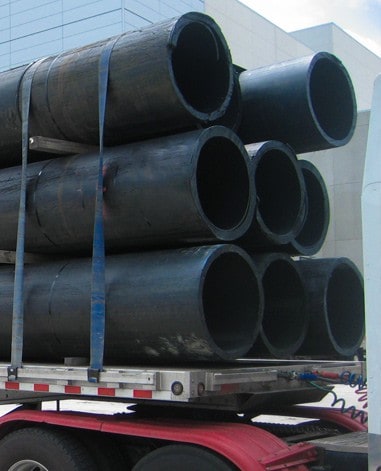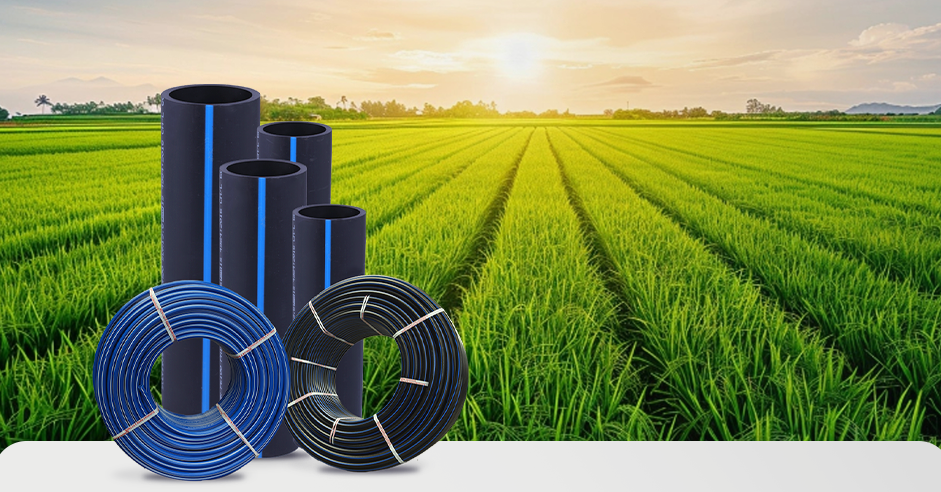Comprehensive Walkthrough to Installing hdpe pipe fittings Midland TX for Long-Term Durability
Check Out the Production Refine Behind High-Quality HDPE Pipe and Its Applications
The manufacturing procedure of high-quality HDPE pipelines is elaborate and methodical. It starts with the option of raw products that improve performance. Following this, ethylene undergoes polymerization to create material, which is after that formed with extrusion. Quality assurance is extremely important, guaranteeing that the end product satisfies rigid criteria. Nevertheless, the journey of HDPE pipes does not finish with manufacturing. Their applications across numerous sectors disclose a broader importance worth checking out.
Recognizing HDPE: Features and Advantages

High-density polyethylene (HDPE) is a functional polycarbonate known for its resilience and resistance to different environmental variables. This product exhibits superb tensile toughness, making it appropriate for requiring applications. Its low-density framework adds to a lightweight product, assisting in simplicity of dealing with and installment. HDPE also showcases remarkable resistance to chemicals, which decreases deterioration when revealed to severe compounds.
The product's reduced moisture absorption even more boosts its longevity, making it ideal for use in pipelines and storage space tanks. Furthermore, HDPE is immune to ultraviolet (UV) radiation, making certain that items maintain their honesty even when revealed to sunshine. Its flexibility enables for the creation of detailed forms without jeopardizing strength. The green nature of HDPE, often stemmed from recycled materials, includes in its charm, promoting lasting methods in manufacturing. In general, these buildings and advantages make HDPE a recommended selection for different commercial and consumer applications.
Raw Product Option for HDPE Production
The choice of resources for HDPE production is necessary to validate the end product fulfills the wanted specs and top quality criteria. High-density polyethylene (HDPE) is mostly generated from polymerized ethylene, acquired from fossil fuels such as gas or petroleum. The quality of these feedstocks considerably affects the mechanical and thermal buildings of the final HDPE.
Ingredients additionally play a substantial role in enhancing HDPE's performance, consisting of anti-oxidants, UV stabilizers, and colorants, which enhance longevity and resistance to ecological variables. The option procedure have to consider not just the chemical structure of the raw materials but additionally their processing characteristics to ensure efficient manufacturing.
The sourcing of raw materials need to prioritize sustainability and conformity with environmental regulations, as accountable practices are essential in today's market. Inevitably, careful resources choice lays the structure for generating top notch HDPE pipes appropriate for diverse applications.
The Extrusion Refine: Shaping HDPE Pipe
The extrusion procedure plays a crucial function in forming HDPE pipes, beginning with precise product preparation methods that ensure excellent flow and uniformity. Equally essential is the design of the die, which straight affects the final dimensions and surface area quality of the pipeline. With each other, these factors contribute considerably to the efficiency and top quality of HDPE pipeline manufacturing.
Material Prep Work Techniques
Effective production of HDPE pipelines starts with precise product prep work techniques, specifically the extrusion procedure. Throughout this phase, high-density polyethylene resin is very first dried out to remove wetness, making sure perfect circulation features. The material is after that fed into the extruder, where it undertakes heating and melting, transforming into a viscous state. This heating procedure is very carefully controlled to maintain the product's integrity and efficiency. The liquified HDPE is required with a die, shaping it right pex a to pex b adapter into a continual pipeline kind. Proper temperature level monitoring during extrusion is essential, as it directly impacts the material's residential or commercial properties and the end product top quality. As soon as formed, the HDPE pipeline is i loved this cooled and cut to specified lengths, all set for succeeding handling and applications.
Die Layout Significance
Precision in die design plays a vital role in the extrusion process of HDPE pipes. The die works as the last shaping tool, directly affecting the pipeline's dimensions, wall thickness, and surface coating. A properly designed die warranties consistent material circulation, reducing issues such as abnormalities and weak points. The geometry of the die must be maximized to fit the particular homes of HDPE, including its thickness and thermal behavior throughout extrusion. In addition, the cooling price of the product as it passes through the die can significantly impact the pipeline's architectural stability. Spending in innovative die modern technology is crucial for manufacturers intending to generate high-grade HDPE pipelines that meet market standards and customer assumptions.
High Quality Control Steps in HDPE Production
Numerous aspects affect the top quality of HDPE pipe manufacturing, reliable top quality control steps are essential to assure uniformity and integrity in the last product (American Plastics HDPE Pipe for Oilfield). Trick quality control practices consist of rigorous product inspection, confirming that the raw polyethylene meets established requirements for purity and density. During the extrusion process, parameters such as temperature, stress, and cooling time are carefully kept track of to preserve dimensional accuracy and architectural honesty
Additionally, post-production screening is important; makers often perform hydrostatic tests to examine the pipeline's stamina and resistance to stress. Aesthetic examinations for surface area problems even more improve high quality assurance. Certification from pertinent standards organizations, like ASTM or ISO, provides an added layer of credibility. By executing these comprehensive top quality control measures, suppliers can lessen problems, boost efficiency, and make sure that the HDPE pipes satisfy the particular needs of numerous applications, eventually leading to client complete satisfaction and count on in the product.
Applications of HDPE Pipe Throughout Industries
HDPE pipes are utilized across various fields due to their durability and flexibility. In water distribution systems, they guarantee effective shipment, while in wastewater administration, they supply trusted options for waste transport. In addition, farming irrigation networks benefit from HDPE's resistance to corrosion and adaptability, making it a perfect choice for modern farming methods.

Water Distribution Systems
A substantial number of markets depend on high-density polyethylene (HDPE) pipes for effective water distribution systems. Known for their toughness and resistance to rust, HDPE pipelines are extensively made use of in municipal water supply networks, farming irrigation, and commercial applications. Their light-weight nature facilitates very easy handling and setup, minimizing labor prices and time. Furthermore, HDPE pipes can suit numerous pressure degrees, making them ideal for both low and high-pressure systems. Texas hdpe pipe manufacturer. The flexibility of the product enables for smooth assimilation into existing facilities, lessening the demand for comprehensive excavation. HDPE's resistance to chemical seeping warranties that the water delivered remains secure and clean, making it an ideal option for keeping the top quality of safe and clean water across different industries.
Wastewater Administration Solutions
Efficient water circulation systems also lead the way for innovative wastewater monitoring options, where high-density polyethylene (HDPE) pipelines play a substantial role. Popular for their sturdiness and resistance to rust, HDPE pipelines are suitable useful content for transferring wastewater in various settings. Their flexibility permits simple installation in complicated settings, reducing the need for comprehensive excavation. In addition, HDPE's smooth interior surface minimizes friction, improving flow rates and performance. These pipelines are also resistant to chemical leaching, making sure that pollutants do not compromise the surrounding setting. Industries, municipalities, and therapy centers significantly depend on HDPE pipelines for their integrity and durability, making them a favored choice for modern-day wastewater administration systems. This adaptability emphasizes the vital importance of HDPE pipes throughout numerous applications.
Agricultural Irrigation Networks
Agricultural irrigation networks profit significantly from the use of high-density polyethylene (HDPE) pipes, which give reliable and reliable water delivery to plants. HDPE pipelines are light-weight, making them simple to carry and install, while their versatility enables various configurations in varied terrains. These pipes demonstrate excellent resistance to deterioration, chemicals, and UV radiation, making sure toughness in extreme agricultural environments. In addition, their smooth indoor surface area reduces friction loss, maximizing water flow and decreasing energy prices connected with pumping. The durability of HDPE pipelines, frequently exceeding half a century, adds to decrease maintenance and substitute costs. Farmers significantly count on HDPE pipes to boost irrigation effectiveness and advertise lasting agricultural methods, eventually leading to improved crop returns and resource conservation.

Future Patterns in HDPE Pipeline Technology
As the demand for lasting and effective framework grows, advancements in HDPE pipeline technology are poised to transform various markets. Emerging patterns consist of the assimilation of wise technologies, such as sensors and IoT capabilities, which facilitate real-time tracking of pipeline problems, decreasing maintenance expenses and stopping leakages. In addition, the development of advanced production strategies, such as 3D printing, is enabling the production of complicated, personalized pipeline designs that deal with details task requirements.
The emphasis on recycling and circular economic situation practices is driving the development of HDPE pipes made from recycled products, improving sustainability. Boosted jointing techniques, such as electro-fusion and mechanical fittings, are also improving installation effectiveness and dependability. The growing focus on environmental policies is pressing suppliers to adopt greener production processes, making certain that HDPE pipes not just meet sector criteria yet likewise cultivate an even more sustainable future for infrastructure development.
Regularly Asked Inquiries
Just How Does HDPE Compare to Other Plastic Products?
HDPE outmatches several other plastic products relating to durability, chemical resistance, and adaptability. Its low density and high tensile stamina make it optimal for various applications, usually exceeding choices in both efficiency and longevity.
What Are the Ecological Impacts of HDPE Production?
The environmental impacts of HDPE manufacturing consist of greenhouse gas discharges, energy consumption, and possible contamination from producing processes. Additionally, improper disposal can cause soil and water contamination, raising issues concerning long-term environmental effects.
Can HDPE Pipeline Be Reused?
Yes, HDPE pipes can be recycled. Lots of centers accept utilized HDPE for handling, changing it right into new items. This recycling adds to sustainability initiatives, minimizing plastic waste while preserving sources and power in the manufacturing cycle.
What Is the Life Expectancy of HDPE Pipes?

How Do Temperature Variants Influence HDPE Pipe Efficiency?
Temperature variants substantially influence HDPE pipeline performance, influencing versatility and stamina. High temperatures can result in softening, while low temperature levels might cause brittleness, eventually influencing the pipeline's longevity and suitability for various applications in diverse environments.